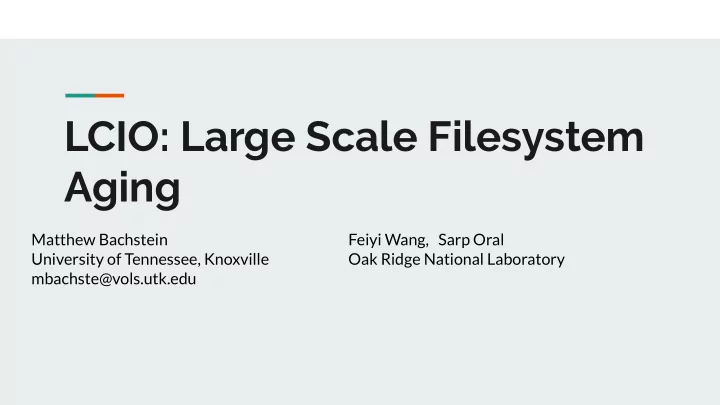

LCIO: Large Scale Filesystem Aging Matthew Bachstein Feiyi Wang, Sarp Oral University of Tennessee, Knoxville Oak Ridge National Laboratory mbachste@vols.utk.edu
Motivation Summit Procurement “Wouldn’t it be great if we could test what they just said.” LifeCycle I/O = LCIO
Why Filesystem Aging? Benchmarks answer: “How does the system perform in the current state?” Filesystem performance => evolution of state over time. “Benchmarking empty file systems cannot provide an accurate assessment of the real-world behavior of a file-system architecture”
Why Aging? However, aging is quite difficult. Have to touch the disk. Two primary approaches exist: Trace Replays Probabilistic Convergence
Trace Replays Smith & Seltzer used a trace replay. Pros: Very accurate, guaranteed to generate the same evolution of states Cons: Slow, effectively serial, relies on a tracefile (which may be huge) I.e. probably fine for a desktop system, probably not good for a PFS
Probabilistic Convergence Probabilistically generated synthetic traces Approach taken by Impressions, Geriatrix Pros: Faster, parallelizable, less input data Amenable to future projections Cons: Garbage in -> Garbage out
Previous Work Impressions Statistically realistic metadata (correct tree depth, file extensions and contents, etc) ~ 30 mins for 12 GB of data (52,000 files, 4000 dirs) Geriatrix Unique in that it focuses on converging to a file age distribution. ~7 hours (420 mins) to age a 90 GB file system
Limitations of Previous Work Not designed with parallel file systems in mind These tools are great for desktop-like systems Their utility in HPC is limited. Need to respect the standard HPC guidelines Scalability and performance
LCIO Approach Focus on file size distribution Pros: Easily paralllelizeable Cons: We trade off realism
LCIO Approach Other minutia: Epochs and ops MPIIO & POSIX Fallocate, fsync, etc….
LCIO Evaluation This distribution is from a large scale (32 PB) Lustre filesystem at OLCF The distribution was truncated to 1GB files from 4TB, miniscule tail probability
LCIO Evaluation Evaluated on a Test and Development, IBM Spectrum Scale, 3.2 PB capacity Exponential increases, 10k - 1 billion files, POSIX only 128 processes / run, 256 for the 1 billion run After each run, IOR and MDtest were run to evaluate how the state changed The 100m and 1b scale runs timed out (8 hour job limit on TDS) Time to completion can be extrapolated from amount completed Each rank had to write a minimum of 400 GiB of traffic
Data Per Rank Number of Files Avg Data written per rank Total Execution Time (s) Time for Initial Image (s) 10k 442 GiB 3,712 7.03 100k 453 GiB 3,678.6 80.4 500k 480 GiB 4,247 386.5 1m 530 GiB 4,710.3 706.9 10m 1.14 TiB 12,515.9 7,573.2 100m Timeout Timeout [72,040] 1b Timeout Timeout [288,160]
Time Per Epoch
Utilization after Aging (TDS 3.2 PB system) Number of Files Used FS capacity (%) Used inodes (%) Base 53.3 (1.71 PB) 68.0 10k 53.3 68.0 100k 53.3 68.0 500k 53.4 68.1 1m 53.7 (1.72 PB) 68.3 10m 56.5 (1.81 PB) 70.0 100m 63.9 (2.05 PB) 75.2 1b 81.7 (2.61 PB) 87.3
What does IOR tell us now? (Means)
What does IOR tell us now? (M-N unique dir)
What does IOR tell us now? (M-N)
What does IOR tell us now? (M-1)
Conclusions File system benchmarking is complicated Have to consider aging Be careful with means -> consider variance LCIO ages large parallel file systems, in a flexible, scalable manner Designed to be used alongside other tools (MDtest, IOR, etc)
References Agrawal, N., Arpaci-Dusseau, A.C., Arpaci-Dusseau, R.H.: Generating realistic impressions for file-system benchmarking. Trans. Storage, 5(4), 16:1–16:30 (Dec 2009). https://doi.org/10.1145/1629080.1629086, http://doi.acm.org/10.1145/1629080.1629086 Axboe, J.: FIO: Flexible I/O Tester.https://github.com/axboe/fio Conway, A., et al: File systems fated for senescence? nonsense, says science! In: 15th USENIX Conference on File and Storage Technologies (FAST 17). pp. 45–58. USENIX Association, Santa Clara,CA (2017), https://www.usenix.org/conference/fast17/technical-sessions/presentation/conway IBM: IBM Spectrum Scale.https://en.wikipedia.org/wiki/IBM_Spectrum_Scale (2018) Kadekodi, S., Nagarajan, V., Ganger, G.R.: Geriatrix: Aging what you see and what you don’t see. a file system aging approach for modern storage systems. In: 2018 USENIX Annual Technical Conference (USENIX ATC 18). pp. 691–704.USENIX Association, Boston, MA (2018),https://www.usenix.org/conference/atc18/presentation/kadekodi LLNL:IOR HPC Benchmark.https://www.nersc.gov/users/computational-systems/cori/nersc-8-procurement/trinity-nersc-8-rfp/nersc-8-trinity-benchmarks/ior/"(2017)
References (cont.) (NERSC), N.E.R.S.C.C.:MDtest. https://www.nersc.gov/users/computational-systems/cori/nersc-8-procurement/trinity-nersc-8-rfp/nersc-8-trinity-benchmarks/mdtest (2013) OLCF, O.R.L.C.F.: SPIDER Storage System.https://www.olcf.ornl.gov/olcf-resources/data-visualization-resources/spider/ (2018) OpenSFS: Lustre. http://lustre.org/documentation/ (2018) Smith, K.A., Seltzer, M.I.: File system aging - increasing the relevance of file system benchmarks. SIGMETRICS Perform. Eval. Rev. 25(1), 203–213 (Jun 1997). https://doi.org/10.1145/258623.258689, http://doi.acm.org/10.1145/258623.258689 Traeger, A., Zadok, E., Joukov, N., Wright, C.P.: A nine year study of file system and storage benchmarking. Trans. Storage 4(2), 5:1–5:56 (May2008). https://doi.org/10.1145/1367829.1367831,http://doi.acm.org/10.1145/1367829.1367831 12. Vazhkudai, S.S., et al: The design, deployment, and evaluation of the coral pre-exascale systems. In: Proceedings of the International Conference for High Per-formance Computing, Networking, Storage, and Analysis. pp. 52:1–52:12. SC ’18,IEEE Press, Piscataway, NJ, USA (2018),http://dl.acm.org/citation.cfm?id=3291656.329172 Wang, F., Sim, H., Harr, C., Oral, S.: Diving into petascale production file systems through large scale profiling and analysis. In: Proceedings of the 2Nd Joint International Workshop on Parallel Data Storage & Data Intensive Scalable Computing Systems. pp. 37–42. PDSW-DISCS ’17, ACM, New York, NY, USA (2017). https://doi.org/10.1145/3149393.3149399, http://doi.acm.org/10.1145/3149393.3149399
Recommend
More recommend